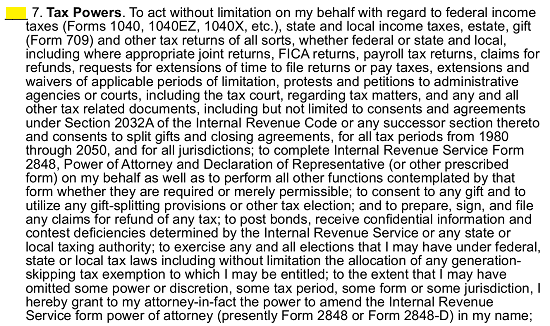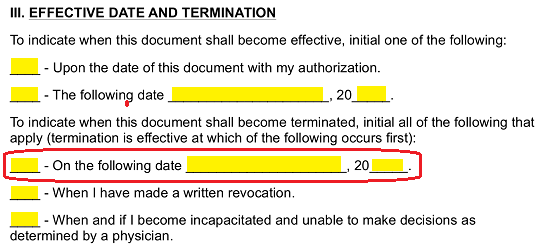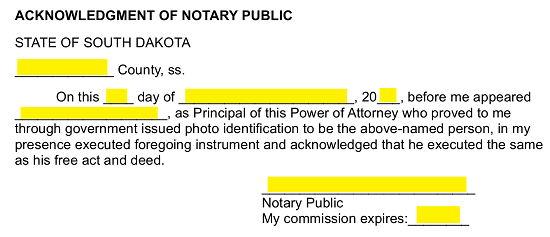Updated August 09, 2023
A South Dakota General (Financial) Power of Attorney Form functions as an official document enabling you to grant powers to another to handle your money and assets on your behalf. This delegation of authority will give an agent the principal power to carry out your directives so long as they are clearly stated and a time period when the agent can represent you is defined. Any principal powers delivered to the agent through this paperwork will automatically terminate if (or when) a physical proclaims you have been incapacitated and cannot communicate effectively with others. Such a declaration must be made in writing, however, once this diagnosis is issued, this paperwork will terminate automatically. Many consider this a failsafe, especially if the named agent should only be acting under the auspices of the principal. If you would like to have your POA continue even if you become incapacitated, you should consider using the durable form.
Laws
- Statutes – Uniform Power Of Attorney Act
- Authority (SDCL § 59-12-23) – An agent under a power of attorney may act on behalf of the principal and exercise broad authority as granted by the agreement.
- Signing Requirements (SDCL § 59-12-4) – Notary Public.
How to Write
Download: PDF, MS Word, OpenDocument
1 – The Beginning Of This Document Must Be Prepared Before Presentation To The Principal
Notice the blank line in the Title (located on the first page). You must fill in the Principal’s Legal Name on this line. The Principal issuing this document will be the individual who intends to appoint an Agent with the same Authority he or she has in certain matters.  Next, in the first paragraph, transcribe the Principal’s Full Name from the Title above. These areas will require the Principal’s Name to be identical.
Next, in the first paragraph, transcribe the Principal’s Full Name from the Title above. These areas will require the Principal’s Name to be identical.  The Address where the Principal maintains his or her Residence will also need to be recorded in this area. Locate the next blank line in this statement, then fill in the Building Number, Street Name, Unit Number, and City of the Principal’s Residential Address.
The Address where the Principal maintains his or her Residence will also need to be recorded in this area. Locate the next blank line in this statement, then fill in the Building Number, Street Name, Unit Number, and City of the Principal’s Residential Address.  This Address must be presented in full, thus use the next empty line to record the State where the Principal maintains his or her Address of Residence
This Address must be presented in full, thus use the next empty line to record the State where the Principal maintains his or her Address of Residence The Agent who will act as the Principal’s Attorney-in-Fact will need to be identified here as well. Begin by supplying this individual’s Legal Name on the line that follows the term “…Hereby Designate.”
The Agent who will act as the Principal’s Attorney-in-Fact will need to be identified here as well. Begin by supplying this individual’s Legal Name on the line that follows the term “…Hereby Designate.” The Agent or Attorney-in-Fact’s Address of Residence will need to be supplied to the fifth empty line of this sentence. 9
The Agent or Attorney-in-Fact’s Address of Residence will need to be supplied to the fifth empty line of this sentence. 9 The final blank space has been reserved for the Attorney-in-Fact’s State of Residence.
The final blank space has been reserved for the Attorney-in-Fact’s State of Residence.
2 – A Principal Review Of The Powers Granted And When They Are Available Is Required
The next task set forth to properly execute this document will require the Principal’s Initials supplied by the Principal. He or she will need to read each paragraph item in the first Article of this paperwork, “I. Powers,” then determine if it describes decisions the Attorney-in-Fact can make on his or her behalf and actions the Attorney-in-Fact may take in his or her Name. If so, the Principal must place his or her initials on the blank space that precedes the bold title of the paragraph being approved. If the Principal will not approve the Attorney-in-Fact’s decisions and actions in the paragraph being reviewed, then he or she should not initial the blank line preceding it.
The Principal Power to handle debts, whether paying or collecting on, on behalf of the Principal can be appointed to the Attorney-in-Fact when the Principal initials the empty line that precedes the paragraph label “1. Power To Make Payments Or Collect Monies Owed.” Any of the actions defined here may be taken by the Attorney-in-Fact in relation to this subject if this Power is granted to the Attorney-in-Fact. If the Principal has decided the Attorney-in-Fact can obtain Personal Property on behalf of the Principal, Lease it, Sell it, or take actions that enable such business, then the Principal should grant this Power to the Attorney-in-Fact by initialing “2. Power To Acquire, Lease And Sell Personal Property.”
If the Principal has decided the Attorney-in-Fact can obtain Personal Property on behalf of the Principal, Lease it, Sell it, or take actions that enable such business, then the Principal should grant this Power to the Attorney-in-Fact by initialing “2. Power To Acquire, Lease And Sell Personal Property.” Similarly, the Principal can grant the Attorney-in-Fact the Authority to Acquire Real Property in his or her Name, Lease or Sell his or her Real Property, and a variety of actions required to achieve this goal by in initialing “3 Power To Acquire, Lease And Sell Property.”
Similarly, the Principal can grant the Attorney-in-Fact the Authority to Acquire Real Property in his or her Name, Lease or Sell his or her Real Property, and a variety of actions required to achieve this goal by in initialing “3 Power To Acquire, Lease And Sell Property.” The same “Management Powers” the Principal has can be appointed to the Attorney-in-Fact’s Principal Powers when the Principal initials “4. Management Powers.” This Principal Power will include the management of Intangible Principal Property as well as Tangible Principal Property
The same “Management Powers” the Principal has can be appointed to the Attorney-in-Fact’s Principal Powers when the Principal initials “4. Management Powers.” This Principal Power will include the management of Intangible Principal Property as well as Tangible Principal Property The Principal Power to engage in Principal Banking Decisions and Actions with financial institutions that perform such transactions can be delivered to the Attorney-in-Fact through the Principal’s Initials when he or she initials “5. Banking Powers.”
The Principal Power to engage in Principal Banking Decisions and Actions with financial institutions that perform such transactions can be delivered to the Attorney-in-Fact through the Principal’s Initials when he or she initials “5. Banking Powers.” The Attorney-in-Fact can be given the Principal Authority to represent the Principal with his or her Motor Vehicles through the wording in “6. Motor Vehicles.” If the Attorney-in-Fact should be able to perform actions such as transfer Titles in the Principal’s Name according to the circumstances defined in this paragraph, then the Principal should initial the blank line that precedes it.
The Attorney-in-Fact can be given the Principal Authority to represent the Principal with his or her Motor Vehicles through the wording in “6. Motor Vehicles.” If the Attorney-in-Fact should be able to perform actions such as transfer Titles in the Principal’s Name according to the circumstances defined in this paragraph, then the Principal should initial the blank line that precedes it. The Principal can assign the Attorney-in-Fact with the Authority to act with Principal Power with his or her Local, State, and Federal Taxes. While the Department of Revenue may have its own criteria for some actions, the Principal will generally give “Tax Powers” to the Attorney-in-Fact when he or she initials “7. Tax Powers.”
The Principal can assign the Attorney-in-Fact with the Authority to act with Principal Power with his or her Local, State, and Federal Taxes. While the Department of Revenue may have its own criteria for some actions, the Principal will generally give “Tax Powers” to the Attorney-in-Fact when he or she initials “7. Tax Powers.” The Attorney-in-Fact will be granted the Authority he or she requires to access and control the Safe-Deposit Boxes the Principal has when the Principal initials the eighth paragraph subject.
The Attorney-in-Fact will be granted the Authority he or she requires to access and control the Safe-Deposit Boxes the Principal has when the Principal initials the eighth paragraph subject. The Principal will give the same Powers to make Gifts he or she has. “9. Gift Making Powers” will give the Attorney-in-Fact a limited amount of Principal Authority to make Gifts in the name of the Principal
The Principal will give the same Powers to make Gifts he or she has. “9. Gift Making Powers” will give the Attorney-in-Fact a limited amount of Principal Authority to make Gifts in the name of the Principal The next paragraph, “10. Lending And Borrowing,” will enable the Attorney-in-Fact to take out Loans in the Principal’s Name or Borrow Money. The Attorney-in-Fact will be able to do a host of actions related to this, including the ability to arrange or make payments. The Principal can grant these Powers to the Attorney-in-Fact by initialing the line corresponding to the tenth paragraph.
The next paragraph, “10. Lending And Borrowing,” will enable the Attorney-in-Fact to take out Loans in the Principal’s Name or Borrow Money. The Attorney-in-Fact will be able to do a host of actions related to this, including the ability to arrange or make payments. The Principal can grant these Powers to the Attorney-in-Fact by initialing the line corresponding to the tenth paragraph. If the Principal has determined the Attorney-in-Fact should be able to negotiate, enter, and obligate the Principal to Contracts, the Principal should initial “11. Contracts.”
If the Principal has determined the Attorney-in-Fact should be able to negotiate, enter, and obligate the Principal to Contracts, the Principal should initial “11. Contracts.”![]() The Principal can give the Attorney-in-Fact the Principal Power to handle a variety of Health Care concerns on behalf of the Principal (such as arranging for admission to a Health Care Facility) when he or she initials “12. Health Care.”
The Principal can give the Attorney-in-Fact the Principal Power to handle a variety of Health Care concerns on behalf of the Principal (such as arranging for admission to a Health Care Facility) when he or she initials “12. Health Care.” The paragraph labeled “13. HIPAA” will give the Attorney-in-Fact the Representational Powers described in the Health Insurance Portability And Accountability Act Of 1996 when it is initialed by the Principal.
The paragraph labeled “13. HIPAA” will give the Attorney-in-Fact the Representational Powers described in the Health Insurance Portability And Accountability Act Of 1996 when it is initialed by the Principal. The Principal can assign the Attorney-in-Fact with the Principal Power to handle affairs such as arranging and paying for services relating to Principal Matters. The Principal will need to initial “14. Power To Hire And Pay For Services” to approve the Attorney-in-Fact’s use of Principal Powers in this area.
The Principal can assign the Attorney-in-Fact with the Principal Power to handle affairs such as arranging and paying for services relating to Principal Matters. The Principal will need to initial “14. Power To Hire And Pay For Services” to approve the Attorney-in-Fact’s use of Principal Powers in this area. The Attorney-in-Fact can act as the Principal in decisions regarding Reimbursement of the Attorney-in-Fact and to take appropriate actions on behalf of the Principal by initialing “15. Reimbursement Of Attorney-in-Fact.”
The Attorney-in-Fact can act as the Principal in decisions regarding Reimbursement of the Attorney-in-Fact and to take appropriate actions on behalf of the Principal by initialing “15. Reimbursement Of Attorney-in-Fact.”![]() The Principal can Approve of the Attorney-in-Fact’s use of Principal Powers to Sue Third Parties that do not comply with the Principal’s Directives as per this document. This Principal must initial “16. Power To Sue Third Parties Who Fail To Act Pursuant To Power Of Attorney”
The Principal can Approve of the Attorney-in-Fact’s use of Principal Powers to Sue Third Parties that do not comply with the Principal’s Directives as per this document. This Principal must initial “16. Power To Sue Third Parties Who Fail To Act Pursuant To Power Of Attorney” The Principal can deliver additional Principal Powers by listing them on the blank lines in “17. Other – Power To Conduct The Following” then initialing the empty line that precedes the number 17.
The Principal can deliver additional Principal Powers by listing them on the blank lines in “17. Other – Power To Conduct The Following” then initialing the empty line that precedes the number 17. The next area requiring Principal Attention is “III. Effective Date And Termination” where the Principal will designate a Calendar Date when these Powers will become Effective and a Calendar Date when these Powers will Terminate. He or she will do this by initialing a statement defining the beginning of these Powers and initialing a statement that defines their Termination.
The next area requiring Principal Attention is “III. Effective Date And Termination” where the Principal will designate a Calendar Date when these Powers will become Effective and a Calendar Date when these Powers will Terminate. He or she will do this by initialing a statement defining the beginning of these Powers and initialing a statement that defines their Termination. The Principal must initial a blank line that precedes one of the first two choices in this section. If the first statement is initialed, the Start Date for these Principal Powers will be whenever the Principal Signs this paperwork while if the second one is initialed the Principal can use the blank lines within it to list a specific Start Date of these Powers.
The Principal must initial a blank line that precedes one of the first two choices in this section. If the first statement is initialed, the Start Date for these Principal Powers will be whenever the Principal Signs this paperwork while if the second one is initialed the Principal can use the blank lines within it to list a specific Start Date of these Powers. The Principal will also need to initial one of the last three choices in this section. This will indicate the Calendar Date the Principal wishes these Powers to Terminate. The Principal can determine the Termination Date, report it in the statement beginning with “On The Following Date,” then initial this statement.
The Principal will also need to initial one of the last three choices in this section. This will indicate the Calendar Date the Principal wishes these Powers to Terminate. The Principal can determine the Termination Date, report it in the statement beginning with “On The Following Date,” then initial this statement.  If preferred, the Principal can allow these Powers to continue until the Calendar Date he or she revokes it by initialing the sentence “When I Have Made A Written Revocation.”
If preferred, the Principal can allow these Powers to continue until the Calendar Date he or she revokes it by initialing the sentence “When I Have Made A Written Revocation.” If preferred, the Principal can set the Termination of these Powers to be the Date he or she is diagnosed (by a Physician) as incapacitated and unable to make his or her own decisions
If preferred, the Principal can set the Termination of these Powers to be the Date he or she is diagnosed (by a Physician) as incapacitated and unable to make his or her own decisions
3 – The Final Approval Of The Principal Must Occur In The Presence Of A Notary
The Principal will need to approve this document so that it may be taken as a serious representation of his or her intentions. This approval must come in the verifiable form of a Principal Signature that is Dated and Notarized. This process may begin with the Principal report of the current Date. He or she should enter the Date this document is being signed in the statement beginning with “In Witness Whereof…” Two blank lines have been supplied beneath the Date statement (“Principal’s Signature” and “Principal’s Printed Name”). The Principal will need to sign his or her Name on the first blank space then print his or her Name on the second blank space.
Two blank lines have been supplied beneath the Date statement (“Principal’s Signature” and “Principal’s Printed Name”). The Principal will need to sign his or her Name on the first blank space then print his or her Name on the second blank space.
Next, the Attorney-in-Fact’s Full Name should be placed on the first blank line in “Acceptance Of Appointment.” The Attorney-in-Fact will officially accept the Principal Powers here when he or she signs and prints his or her Name in the blank spaces provided  The Notary Public obtained for this appointment of Power will have an area where he or she can notarize this document’s execution.
The Notary Public obtained for this appointment of Power will have an area where he or she can notarize this document’s execution.


